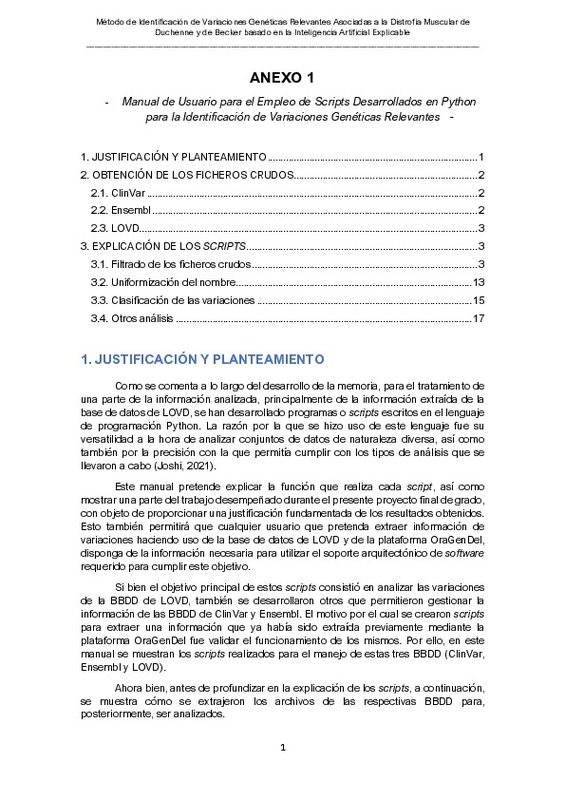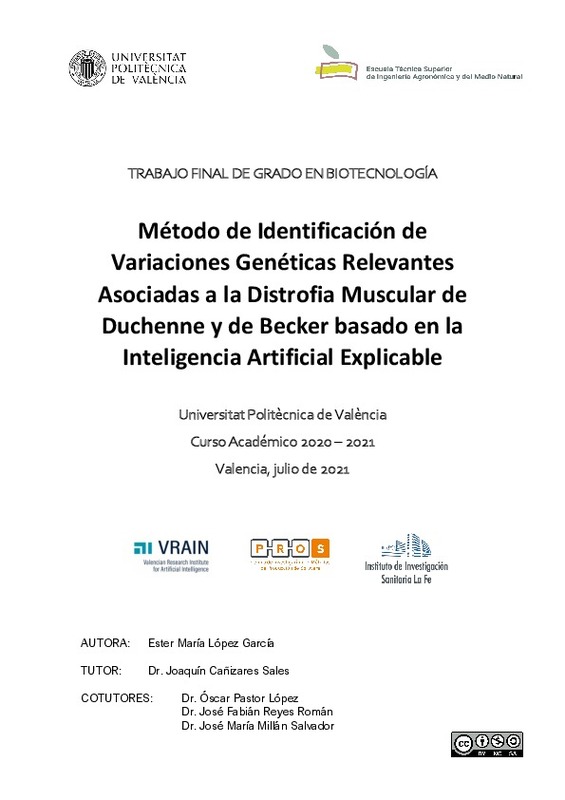JavaScript is disabled for your browser. Some features of this site may not work without it.
Buscar en RiuNet
Listar
Mi cuenta
Estadísticas
Ayuda RiuNet
Admin. UPV
Método de identificación de variaciones genéticas relevantes asociadas a la Distrofia Muscular de Duchenne y de Becker basado en la Inteligencia Artificial Explicable
Mostrar el registro sencillo del ítem
Ficheros en el ítem
| dc.contributor.advisor | Cañizares Sales, Joaquín
|
es_ES |
| dc.contributor.advisor | Pastor López, Oscar
|
es_ES |
| dc.contributor.author | López García, Ester María
|
es_ES |
| dc.date.accessioned | 2021-07-30T14:26:12Z | |
| dc.date.available | 2021-07-30T14:26:12Z | |
| dc.date.created | 2021-07-14 | |
| dc.date.issued | 2021-07-30 | es_ES |
| dc.identifier.uri | http://hdl.handle.net/10251/171055 | |
| dc.description.abstract | [ES] El presente proyecto de fin de grado, impulsado por el grupo de genómica del Centro de Investigación en Métodos de Producción de Software (PROS) de la UPV, miembro del Instituto Valenciano de Inteligencia Artificial (VRAIN), en colaboración con el Dr. José M. Millán, director del Grupo de Investigación en Biomedicina Molecular, Celular y Genómica del IIS La Fe de Valencia, consistió en la identificación de variaciones relevantes asociadas al desarrollo de las enfermedades de distrofia muscular de Duchenne (DMD) y Becker (BMD). Para la consecución de tal tarea, se empleó un método surgido a partir de la unión de dos métodos preexistentes: el método SILE y el método sobre el cual está basado la Inteligencia Artificial Explicable (IAE) . A lo largo del desarrollo del método, se alcanzaron una serie de objetivos específicos que fueron surgiendo a medida que avanzaba el proyecto. Dichos objetivos consistieron en evaluar y contribuir a la evolución de la plataforma de gestión de datos genómicos “Oráculo Genómico de Delfos” (OraGenDel), desarrollada por el Centro PROS, así como en elaborar propuestas de mejora de la misma. También se determinó la importancia de la base de datos de LOVD, considerada de referencia por parte del personal investigador en el ámbito de las distrofinopatías (el grupo de enfermedades entre las cuales se encuentran la DMD y la BMD), dado que la plataforma OraGenDel no presentaba los conectores necesarios para analizar la información de la misma. Por último, se llevó a término un análisis del significado biológico que albergaban las variaciones que se asociaban a los pacientes de ambas enfermedades (DMD y BMD) y que habían sido clasificadas como relevantes en los experimentos previos. De estas enfermedades destaca el hecho de que, al estar incluidas dentro del grupo de Enfermedades Raras por su baja prevalencia (1-9/100000), suelen contar con menos medios para su investigación. No obstante, con este trabajo, se contribuyó a profundizar en el conocimiento de las mismas a nivel molecular. | es_ES |
| dc.description.abstract | [EN] The present end-of-degree project, promoted by the genomics group of the Center for Research on Software Production Methods (PROS) of the UPV, member of the Valencian Institute of Artificial Intelligence (VRAIN), in collaboration with José M. Millán, PhD, director of the Molecular, Cellular and Genomic Biomedicine Research Group of the IIS La Fe of Valencia, consisted in the identification of relevant variations associated with the development of Duchenne muscular dystrophy (DMD) and Becker muscular dystrophy (BMD) diseases. In order to achieve this task, a method was used that arose from the union of two pre-existing methods: the SILE method and a method in which Explainable Artificial Intelligence is based. Throughout the development of this method, a series of specific objectives were achieved, which emerged as the project progressed. These objectives consisted, firstly, in evaluating and contributing to the evolution of the “Delphos Genomic Oracle” genomic data management platform (OraGenDel), developed by PROS, as well as in elaborating proposals for its improvement. Another objective that was achieved was the determination of the importance of the LOVD database, considered as a reference by research staff in the field of dystrophinopathies (the group of diseases among which DMD and BMD are found), given that the OraGenDel platform did not present the needed connectors to analyze the information therein. Finally, an analysis of the biological significance of the variations that were associated with patients with both diseases (DMD and BMD) and that had been classified as relevant in previous experiments was carried out. It is key to point out that given that these diseases are included in Rare Diseases group due to their low prevalence (1-9/100000), they usually have fewer means for their research stands out. However, this work contributed to deepen the knowledge of these diseases at the molecular level. | es_ES |
| dc.format.extent | 77 | es_ES |
| dc.language | Español | es_ES |
| dc.publisher | Universitat Politècnica de València | es_ES |
| dc.rights | Reconocimiento - No comercial - Compartir igual (by-nc-sa) | es_ES |
| dc.subject | Bases de datos genómicas | es_ES |
| dc.subject | Distrofia muscular de Duchenne (DMD) | es_ES |
| dc.subject | Distrofia muscular de Becker (BMD) | es_ES |
| dc.subject | Variaciones genéticas | es_ES |
| dc.subject | Inteligencia artificial explicable | es_ES |
| dc.subject | Duchenne muscular dystrophy (DMD) | es_ES |
| dc.subject | Becker muscular dystrophy (BMD) | es_ES |
| dc.subject | Genetic variants | es_ES |
| dc.subject | Explainable artificial intelligence | es_ES |
| dc.subject | Genomic databases | es_ES |
| dc.subject.classification | LENGUAJES Y SISTEMAS INFORMATICOS | es_ES |
| dc.subject.classification | GENETICA | es_ES |
| dc.subject.other | Grado en Biotecnología-Grau en Biotecnologia | es_ES |
| dc.title | Método de identificación de variaciones genéticas relevantes asociadas a la Distrofia Muscular de Duchenne y de Becker basado en la Inteligencia Artificial Explicable | es_ES |
| dc.type | Proyecto/Trabajo fin de carrera/grado | es_ES |
| dc.rights.accessRights | Abierto | es_ES |
| dc.contributor.affiliation | Universitat Politècnica de València. Departamento de Biotecnología - Departament de Biotecnologia | es_ES |
| dc.contributor.affiliation | Universitat Politècnica de València. Escuela Técnica Superior de Ingeniería Agronómica y del Medio Natural - Escola Tècnica Superior d'Enginyeria Agronòmica i del Medi Natural | es_ES |
| dc.description.bibliographicCitation | López García, EM. (2021). Método de identificación de variaciones genéticas relevantes asociadas a la Distrofia Muscular de Duchenne y de Becker basado en la Inteligencia Artificial Explicable. Universitat Politècnica de València. http://hdl.handle.net/10251/171055 | es_ES |
| dc.description.accrualMethod | TFGM | es_ES |
| dc.relation.pasarela | TFGM\143222 | es_ES |
Este ítem aparece en la(s) siguiente(s) colección(ones)
-
ETSIAMN - Trabajos académicos [3541]
Escuela Técnica Superior de Ingeniería Agronómica y del Medio Natural










